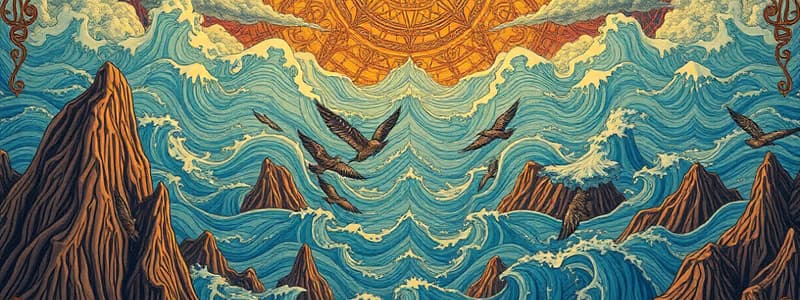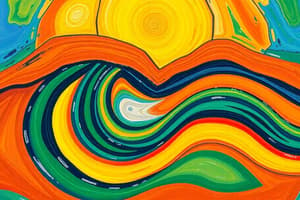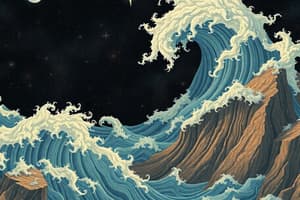Podcast
Questions and Answers
Earthquakes primarily occur due to the movement of tectonic plates.
Earthquakes primarily occur due to the movement of tectonic plates.
True (A)
The epicenter is the point within the Earth where an earthquake begins.
The epicenter is the point within the Earth where an earthquake begins.
False (B)
Fault lines are cracks in tectonic plates where earthquakes often occur.
Fault lines are cracks in tectonic plates where earthquakes often occur.
True (A)
The 'Ring of Fire' is a region exclusively known for its volcanic activity, with no correlation to earthquakes.
The 'Ring of Fire' is a region exclusively known for its volcanic activity, with no correlation to earthquakes.
Earthquakes only happen in the ocean.
Earthquakes only happen in the ocean.
There are fifteen major tectonic plates that make up the Earth's crust.
There are fifteen major tectonic plates that make up the Earth's crust.
Most of the earthquake damage occurs at the focus.
Most of the earthquake damage occurs at the focus.
Earthquakes are more common in mountainous regions.
Earthquakes are more common in mountainous regions.
Seismic waves travel inward towards the earthquake's focus.
Seismic waves travel inward towards the earthquake's focus.
The terms 'Pacific Rim' and 'Ring of Fire' refer to the same earthquake-prone area.
The terms 'Pacific Rim' and 'Ring of Fire' refer to the same earthquake-prone area.
Energy builds up as tectonic plates try to move but get stuck.
Energy builds up as tectonic plates try to move but get stuck.
Earthquakes only occur where tectonic plates collide; they never happen along cracks within a single plate.
Earthquakes only occur where tectonic plates collide; they never happen along cracks within a single plate.
The strength of seismic waves is uniform across the entire surface of the Earth from the point of origin.
The strength of seismic waves is uniform across the entire surface of the Earth from the point of origin.
The Juan de Fuca Plate is located near the San Andreas fault.
The Juan de Fuca Plate is located near the San Andreas fault.
Earthquakes are more frequent in areas with fewer geological faults.
Earthquakes are more frequent in areas with fewer geological faults.
The Cascadia Subduction Zone involves the Pacific Plate sliding beneath the North American Plate.
The Cascadia Subduction Zone involves the Pacific Plate sliding beneath the North American Plate.
Generally, stronger seismic waves are felt far from the epicenter.
Generally, stronger seismic waves are felt far from the epicenter.
Earthquakes are becoming more predictable due to advances in technology.
Earthquakes are becoming more predictable due to advances in technology.
Volcanoes and earthquakes do not occur in the same regions.
Volcanoes and earthquakes do not occur in the same regions.
Earthquakes result from a sudden release of energy in the Earth's lithosphere, creating seismic waves.
Earthquakes result from a sudden release of energy in the Earth's lithosphere, creating seismic waves.
Flashcards
What are Earthquakes?
What are Earthquakes?
Events that cause the ground to shake, occurring along faults on Earth's surface.
What is the Ring of Fire?
What is the Ring of Fire?
An area around the Pacific Ocean known for frequent earthquakes and volcanoes.
What are tectonic plates?
What are tectonic plates?
Giant sheets of rock that make up Earth's surface; their movement causes earthquakes.
What are fault lines?
What are fault lines?
Signup and view all the flashcards
What are seismic waves?
What are seismic waves?
Signup and view all the flashcards
What is the focus of an earthquake?
What is the focus of an earthquake?
Signup and view all the flashcards
What is the epicenter?
What is the epicenter?
Signup and view all the flashcards
Study Notes
- Earthquakes are events that cause the ground to shake.
- They happen along faults, which are cracks on the Earth's surface.
- Earthquakes occur in almost every country.
- There are millions of earthquakes each year, but most are very small.
- Most earthquakes occur around the Ring of Fire, an area around the Pacific Ocean, also known as the Pacific Rim.
- Earthquakes and volcanoes commonly occur in the same areas, particularly mountainous regions.
Formation
- The Earth has seven major tectonic plates, which are giant sheets of rock.
- Tectonic plates move deep below the Earth's surface.
- Plates sometimes get stuck, causing energy to build up.
- When the plates slip, they create seismic waves.
- This release of energy results in an earthquake.
- Earthquakes happen where tectonic plates meet and along fault lines, which are cracks in the plates.
- Seismic waves travel outward from the earthquake's focus.
- The epicenter is the point on the Earth's surface directly above the focus, where the earthquake starts.
- Most damage occurs at the epicenter.
- Strong seismic waves can be felt several miles away from the epicenter.
Studying That Suits You
Use AI to generate personalized quizzes and flashcards to suit your learning preferences.




